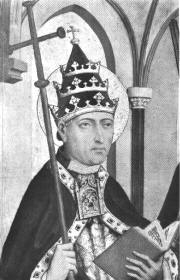 St. Gregory II was a Roman of noble family. From his youth a cleric,
Gregory was made treasurer by St. Sergius, and papal librarian. As a deacon
he accompanied Constantine on his visit to Justinian II and is credited
with the skillful answers which at once satisfied the half-mad monarch and
safeguarded Catholic doctrine and practice. Gregory was consecrated on May
19, 715. A man of virtue and eloquence, he was well versed in Holy
Scripture. Above all, he was prudent and firm.
St. Gregory II was a Roman of noble family. From his youth a cleric,
Gregory was made treasurer by St. Sergius, and papal librarian. As a deacon
he accompanied Constantine on his visit to Justinian II and is credited
with the skillful answers which at once satisfied the half-mad monarch and
safeguarded Catholic doctrine and practice. Gregory was consecrated on May
19, 715. A man of virtue and eloquence, he was well versed in Holy
Scripture. Above all, he was prudent and firm.
Gregory II showed great interest in the vital work of conversion going on
in lands beyond the old empire's far-flung borders. He encouraged St.
Corbinian to keep on sacrificing his desire for solitude and continue his
work among the Bavarians. In 718 Pope Gregory received Winfred, a zealous
young English monk who sought his blessing on a mission to the Germans.
The Pope gave him not only a blessing but a name glorious in the annals of
Christianity--Boniface. He recalled St. Boniface to Rome in 722, questioned
him about his faith, and thoroughly satisfied, consecrated him bishop and
sent him back to his Germans.
Gregory was fond of monks. He turned his ancestral mansion into a monastery
and rebuilt Monte Cassino. This mother abbey of the Benedictines, destroyed
by the Lombards around 580, had been a desolate ruin.
On the Lombards, Gregory had a good influence. He helped them with their
laws. But when these still untamed barbarians began raiding imperial
territory in Italy, Gregory tried to stop them. Loyalty to the Emperor,
however, was becoming difficult.
Leo III, a tough soldier from the Isaurian uplands, had saved the empire
from the Saracens by his spirited defense of Constantinople in 717. Leo was
a very demanding taxgatherer. His impositions caused discontent especially
in Italy, where the small protection afforded by imperial forces made high
taxes seem a bad investment. Discontent flamed higher when in 726 the
Emperor touched not only his subjects' purses but their devotion. Leo,
rough soldier that he was, decided to play the theologian. His pet idea was
to forbid the use of sacred images. Iconoclasm, the Greek word for image
breaking, is a Jewish-Moslem idea, quite alien to Christian tradition. The
imperial decree, issued in 726, provoked riot and rebellion in the East.
More constructively, it occasioned the masterful writings of the great
Eastern doctor of the Church, St. John Damascene.
The imperial decree forbidding images reached Italy in 727. Pope Gregory
held a synod at Rome which stated the traditional teaching of the Church.
He then wrote to Leo reproving him for his meddling and teaching him the
traditional doctrine of the Church. He quite bluntly warned the Emperor
against enforcing his decree in the West. The Pope also supported the
deposed patriarch of Constantinople and threatened his intruded successor.
Leo sent a fleet to seize the Pope, but a storm destroyed it. He did seize
the estates of Peter's patrimony in Sicily and Calabria. His officials in
Italy were prevented by the aroused Italians and the Lombards from taking
measures against the Pope. The Italians wished to set up a rival emperor,
but Gregory dissuaded them. The extraordinary circumstances forced Gregory
to assume more temporal power in Rome.
This great Pope died in February 731. His feast is kept on February 13.
Excerpted from "Popes
Through the Ages" by Joseph Brusher, S.J.

